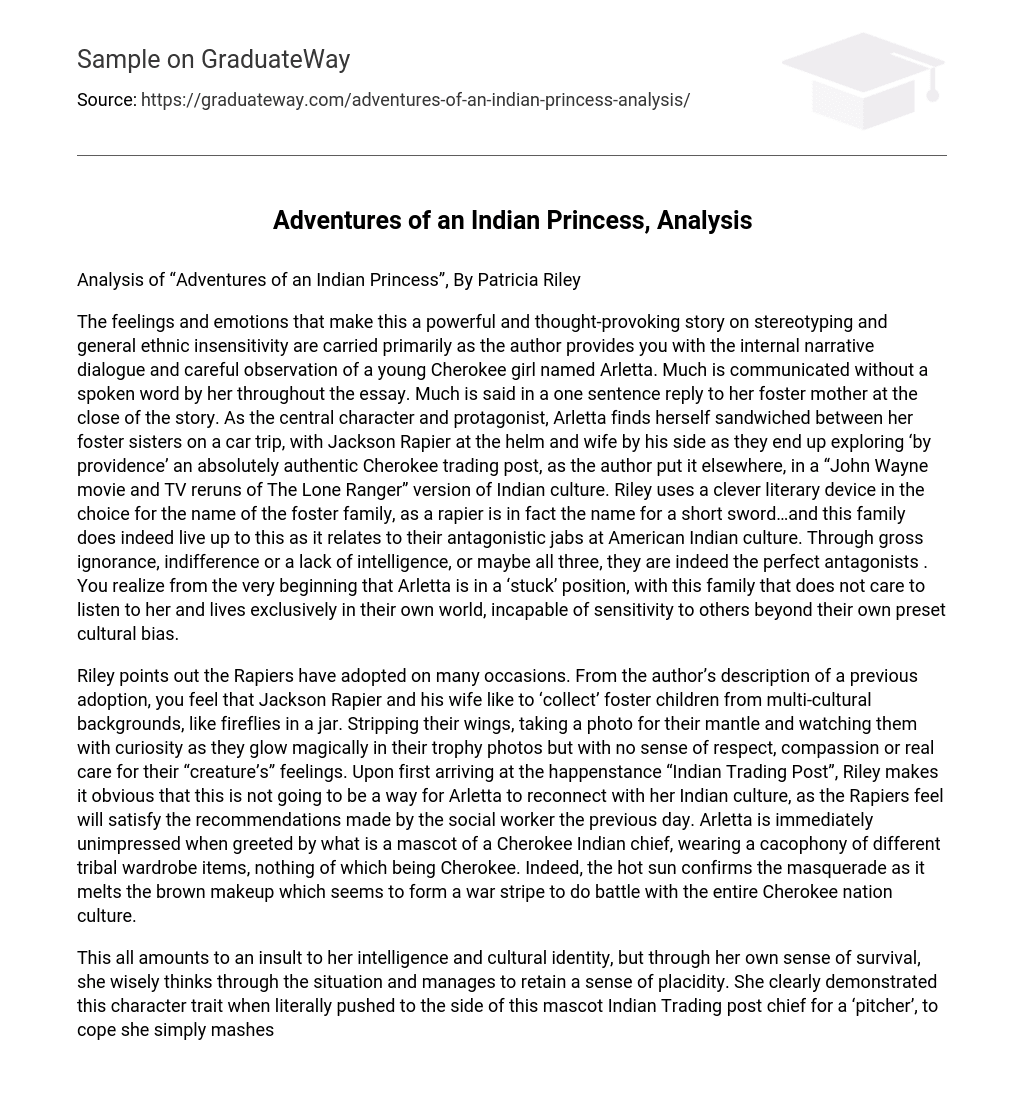Analysis of “Adventures of an Indian Princess”, By Patricia Riley
The feelings and emotions that make this a powerful and thought-provoking story on stereotyping and general ethnic insensitivity are carried primarily as the author provides you with the internal narrative dialogue and careful observation of a young Cherokee girl named Arletta. Much is communicated without a spoken word by her throughout the essay. Much is said in a one sentence reply to her foster mother at the close of the story. As the central character and protagonist, Arletta finds herself sandwiched between her foster sisters on a car trip, with Jackson Rapier at the helm and wife by his side as they end up exploring ‘by providence’ an absolutely authentic Cherokee trading post, as the author put it elsewhere, in a “John Wayne movie and TV reruns of The Lone Ranger” version of Indian culture. Riley uses a clever literary device in the choice for the name of the foster family, as a rapier is in fact the name for a short sword…and this family does indeed live up to this as it relates to their antagonistic jabs at American Indian culture. Through gross ignorance, indifference or a lack of intelligence, or maybe all three, they are indeed the perfect antagonists . You realize from the very beginning that Arletta is in a ‘stuck’ position, with this family that does not care to listen to her and lives exclusively in their own world, incapable of sensitivity to others beyond their own preset cultural bias.
Riley points out the Rapiers have adopted on many occasions. From the author’s description of a previous adoption, you feel that Jackson Rapier and his wife like to ‘collect’ foster children from multi-cultural backgrounds, like fireflies in a jar. Stripping their wings, taking a photo for their mantle and watching them with curiosity as they glow magically in their trophy photos but with no sense of respect, compassion or real care for their “creature’s” feelings. Upon first arriving at the happenstance “Indian Trading Post”, Riley makes it obvious that this is not going to be a way for Arletta to reconnect with her Indian culture, as the Rapiers feel will satisfy the recommendations made by the social worker the previous day. Arletta is immediately unimpressed when greeted by what is a mascot of a Cherokee Indian chief, wearing a cacophony of different tribal wardrobe items, nothing of which being Cherokee. Indeed, the hot sun confirms the masquerade as it melts the brown makeup which seems to form a war stripe to do battle with the entire Cherokee nation culture.
This all amounts to an insult to her intelligence and cultural identity, but through her own sense of survival, she wisely thinks through the situation and manages to retain a sense of placidity. She clearly demonstrated this character trait when literally pushed to the side of this mascot Indian Trading post chief for a ‘pitcher’, to cope she simply mashes her teeth with a visible grimace. But she does retain her dignity nonetheless by not complying with the ‘clever’ demands by Jackson Rapier to say ‘Cherokee’ during the photo shoot. This ability to think beyond the immediate circumstances is present throughout Arletta’s dreadful adventure to the trading post. The inspiration for the title element “Indian Princess” came when Mrs. Rapier reacts to her husband’s photo opportunity with the trading post chief, noting that she resembled an Indian Princess further establishes the Rapiers indifference or lack of knowledge concerning their foster child’s culture. As anyone familiar with American Indian culture would know (as one would hope if adopting a Native American) , Indian tribes are formed in a non-hierarchal way, and most certainly would not recognize an Indian Princess as a formal designation. Riley’s choice for placing this in the title to the story is certainly most telling of the central theme.
The tortuous car ride in the back seat with her passive aggressive foster sisters, the extreme heat and grossly negligent authenticity of the Indian Trading post and the drunken trading post chief all come to head at the end of the story. Arletta literally cannot stomach anymore of this, and as a reader, can you blame her? Mrs. Rapier’s reaction to her foster child being sick and throwing up in the backseat onto her Made in Japan authentic Indian artifacts is a strong footnote to support the author’s point that these people simply do not care about this child’s feelings. And despite all of this, Arletta closes the story with her own sense of humor with a sharp but polite retort to Mrs. Rapier’s notion that she should be ashamed of herself for ruining the authentic Indian artifacts. By saying ‘No, Maam, I’m not” she politely maintains her dignity and rose above the situation to cope with the ignorance and outright crudeness at times that was on full display with her foster family. In this sense, she truly embodies what one would imagine to be the best ‘regal’ qualities of a mythical Indian Princess.





